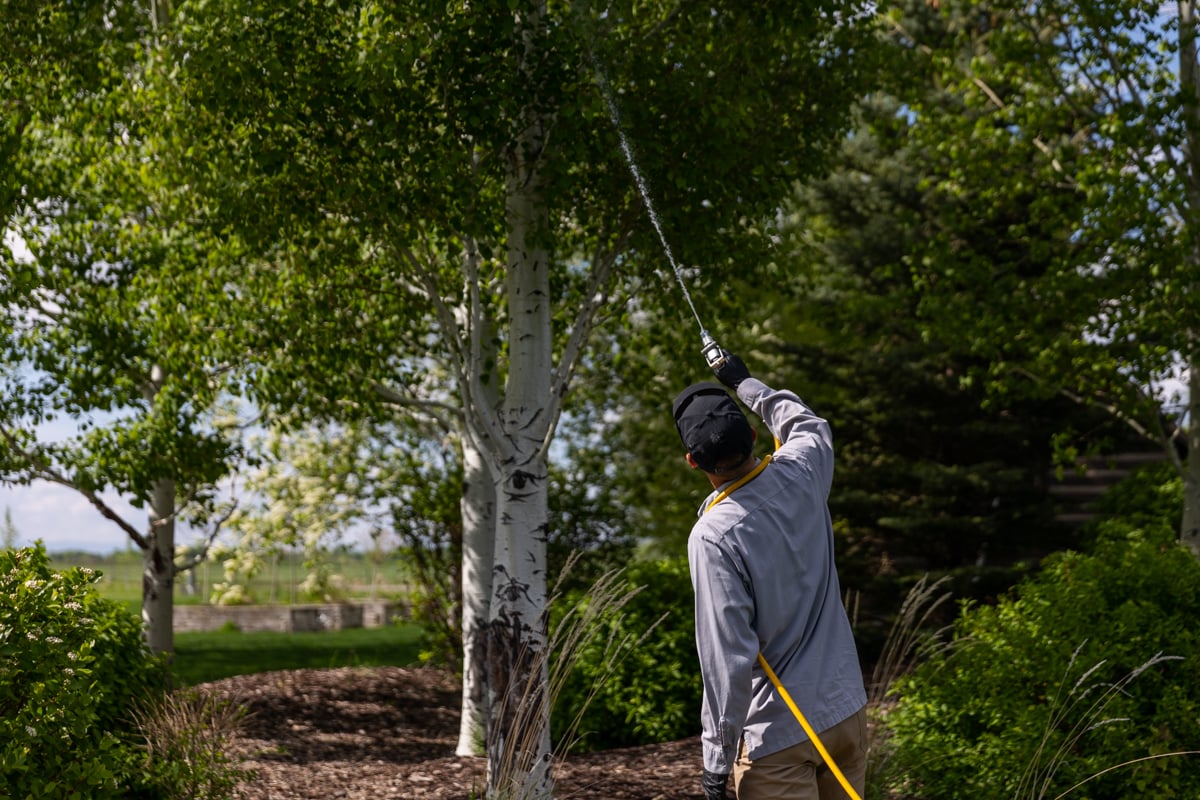How to Fertilize Young Trees and Shrubs: 6 Tips for Idaho Homeowners
You might have your lawn fertilizing routine down, but what about your trees and shrubs?
They’re hungry, too, right?
Fertilizer gives trees and shrubs a boost that improves their health and appearance, from strong roots to glossy leaves to plentiful, pretty flowers.
But how soon do you start? Is fertilizing new plants important? What should you use?
Let’s take a look:
1. First, Hold Off on That Fertilizer
It’s tempting to give a new tree or shrub a big dose of fertilizer to get started. Grow, baby, grow!
But it’s best to hold off on fertilizer when caring for new plants. You don’t want to encourage a bunch of growth before the tree or shrub gets established.

Newly planted trees and shrubs can’t absorb those tasty nutrients until they grow an adequate root system. So resist the temptation to feed those babies. Tree fertilization too soon can actually prevent good root growth.
2. Focus on Roots First
Instead, give your new tree or shrub a root stimulant product to help the plant take root, establish a healthy root system, and increase soil fertility.
These products have low fertilizer content — the ingredients are more focused on root promotion over top growth.
3. Fertilizing New Plants: Time for 16-16-16
Once your new tree or shrub has had a few months to settle in, you can apply that fertilizer.
Here at Lawn Buddies, we use a 16-16-16 fertilizer — a good all-purpose fertilizer that can be used on most plants.

This 16-16-16 blend of fertilizer is a balanced mix of 16% nitrogen, 16% phosphorus, and 16% potassium that nicely feeds most plants, including flowering trees and shrubs.
A 16-16-16 blend boosts trees and shrubs in several ways:
- Nitrogen (N): Helps with photosynthesis and leafy green growth
- Phosphorus (P): Stimulates blooming
- Potassium (K): Helps build strong roots and improves overall plant hardiness.
When you’re wandering the fertilizer aisle, you’ll notice not all the bags have a tidy 16-16-16.
Other blends will say 5-10-10 or 20-10-10 and you’ll see the letters N, P, and K.
Each number refers to the nitrogen, phosphorus, and potassium we just mentioned — in that order.
In case you don't remember the periodic table from science class, N stands for nitrogen, P for phosphorus, and K for potassium.
A fertilizer that contains 5-10-10 means it has 5 percent nitrogen, 10 percent phosphorus and 10 percent potassium.
Different formulas are designed for different needs.
4. Next Up: Deep Root Tree Fertilization
After about a year, when your tree has taken root and is established, it’s a great time for a deep root fertilizer.
Deep root tree fertilization injects nutrients for your tree directly deep into the soil, rather than spreading it over the top.
By injecting the fertilizer with high pressure, the nutrients can reach the deepest tree roots fast, feeding your tree from the roots up.
The fertilizer is delivered straight to the tree’s roots, with a long, cool-looking wand, so your tree gets an immediate nutrition boost.
Then, over time, the nutrients make their way to the rest of your tree, making it healthier and more vibrant.
Fall is a great time for deep root tree fertilization in Idaho. The deep feeding will bolster your trees after the stress of a long, hot summer of growing, and set them up in good shape for the winter ahead.
5. Tree Fertilization Mistakes to Avoid
Moving ahead, a couple pro tips will make sure you don’t mess up this whole fertilizing thing:
- Don’t fertilize trees and shrubs with high nitrogen fertilizer after mid-August. That late-summer feeding can cause some plants to put out a new flush of growth that could be susceptible to early frost damage.
- Don’t fertilize trees and shrubs during the stress of drought unless you’re watering them regularly. They can’t use that fertilizer without enough water. Some fertilizers may actually damage the roots and scorch the leaves if water is lacking.
It's important to feed your plants, but only when they're hungry. Poorly-timed fertilization can cause unintended plant damage, or waste expensive product when your plants aren't ready to take in those nutrients.
6. Pro Plant Health Care
Trees & shrubs in Idaho have a lot going on, from surviving harsh winters to fending off hungry destructive tree borers and aphids to dealing with a weird nutrient deficiency called “iron chlorosis” that keeps leaves from turning green.

All of this means occasional tree and shrub maintenance to prevent diseases, battle bugs, and feed your hard-working trees and shrubs so they’re strong and healthy enough to stand up to whatever Idaho dishes out.
Lawn Buddies plant pros know exactly what your precious trees and shrubs need and exactly when they need it.
Caring for New Plants? Leave it to Lawn Buddies
Get your new leafy pals off to a great start with plant health care and landscaping services in Boise and Idaho Falls that know exactly what they need — and don’t need.
Leave it all to us.
Expert tree and shrub maintenance is available for our Idaho Falls and Boise customers who use our full-service lawn care program.
The first step is to sign up for our 6-step complete lawn care program.
You’ll be glad you did.
Choose an Idaho Falls or Boise professional lawn care service that makes it easy, bundling your yard’s most-needed treatments into one convenient, no-fuss plan.
Fertilizing, weed control, grub control. Done. Expert tree and shrub maintenance: double done.
Got a few minutes? That’s all you need to get started. Fill out the form on this page, call us at (208) 656-9131 or visit our site to read more about our services. Then, you can kick back and relax in your healthy, thriving yard.


